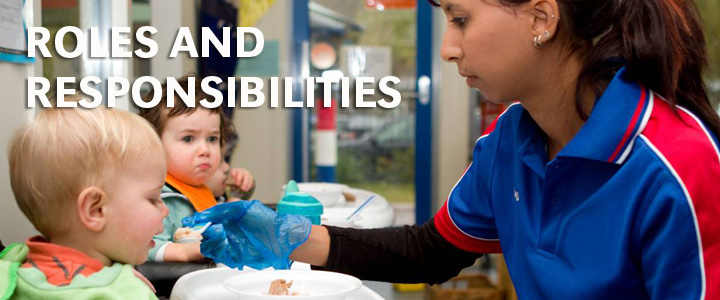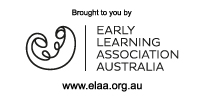Roles and responsibilities

Everyone involved in an early childhood organisation has a role to play in ensuring the service's operations are safe and without risk to health. This includes the committee (when they are the employer), employees, contractors (including agency or labour hire personnel) and parents. When the committee does not have employer responsibilities (such as a site committee in services where cluster managers are the employer), they still have an obligation to report OHS concerns to the employer; however, they do not have the responsibilities that the OHS Act 2004 confers on employers.
The owners of the organisation's building, designers of buildings and those who supply chemicals, tools and machinery to services each have legal OHS duties under the Act. These duties relate to those matters for which they have management that could impact on OHS. Even the general public have a legal duty to act responsibly when visiting a service.
Employer
- Provide and maintain for employees a workplace that is safe and without risk to health. This responsibility extends to contractors for matters over which the employer has management. For example, the employer must ensure that OHS for agency staff relieving or replacing the organisation's employees is managed consistently with how OHS is managed for employees. And for contractors completing non-routine tasks, the employer must ensure that the service's daily operations and layout do not pose unreasonable risks to the contractor.
- Ensure other persons, such as families, visitors and contractors, are not exposed to risks to their health and safety arising from the organisation's activities.
- Consult with their employees about OHS matters that will or are likely to directly affect employees, including identifying hazards and assessing risks, and making decisions about measures to control risks. The OHS policy and practical guidance in the form of procedures, forms and checklists provided in this website will help the employer fulfil these responsibilities.
Employee
- take care of their own safety and the safety of others that may be affected by their actions
- cooperate with reasonable OHS actions taken by the employer. In a practical sense this would include following OHS rules and guidelines, helping to ensure housekeeping is of a reasonable standard, attending OHS related training, reporting OHS incidents, cooperating with OHS investigations, encouraging good OHS practice with fellow employees and others and, wherever practical, assisting the employer when the employer ask employees for help with OHS, such as conducting OHS inspections during operating hours
- not interfere with safety equipment, such as fire extinguishers.
Health and safety representatives
Health and safety representatives (HSRs) are employees elected by their peers to formally represent them in OHS matters, including where there is consultation about OHS issues with their employer. Under the OHS Act 2004, HSRs have a role – as distinct from a legal duty or responsibility – to help raise and help resolve OHS issues.
Note that HSRs are employee representatives and are therefore distinct and separate from employer representatives, such as members of committee's of management or cluster managers.
In addition, the Act provides for certain legal powers for HSRs to take issues further if necessary. One of the powers of an HSR is to issue a Provisional Improvement Notice (PIN) in the event that the HSR believes on reasonable grounds that there is an OHS issue related to the organisation's activities, where this issue breaches the OHS Act 2004 or OHS Regulations 2007. PINs should only be issued by an HSR as a last resort, when all efforts to consult with the employer have failed. The employer can appeal to WorkSafe Victoria if they disagree with the PIN. For more urgent OHS issues, HSRs and the employer both have the legal power to issue a cease work where there is an immediate threat to health and safety.
HSRs can facilitate more effective OHS consultation between the employer and employees, and therefore enhance OHS. However, it is important to note that the employer must not coerce employees into being HSRs, and that HSRs should be nominated by their peers rather than selected by the employer.
It is also highlighted that an employer can meet their legal obligations regarding OHS consultation (OHS Act 2004 Sections 35 and 36) with employees if they consult about OHS issues that are likely to affect these employees, even if there are no HSRs. Furthermore, employees are also able to nominate for an employee to represent them for a specific OHS issue, if required, rather than have an elected HSR. This is a very practical approach to employee representation, where services have very low employee numbers.
HSRs are entitled to WorkSafe approved HSR training during their work hours, with the cost of the course paid by the employer. There is a five day HSR Initial Course and a one day HSR Refresher Course available every year thereafter, if necessary. This HSR training is not mandatory. Generally if HSRs wish to attend this training, the employer should proactively make it possible for the HSR to attend this training.
Finally, it is important to note that HSRs do not have any additional legal duties in their capacity as HSRs. Therefore, the employer should not consider the HSR role as a delegate or extension of the employer. Stated another way, the employer's OHS responsibilities and legal duties are non-delegable to others, including HSRs. The best approach is for both employer and HSRs to work collaboratively to enhance OHS at their service.
An excellent resource that explains the role of HSRs and employee representation is a WorkSafe Victoria publication entitled Employee Representation. This publication is available for download from WorkSafe Victoria's website www.worksafe.vic.gov.au (then select 'Publications' tab), or in hard copy by calling (03) 9641 1444 and selecting the 'publications' phone menu option.
OHS committees
Employers may proactively establish an OHS committee. An OHS committee is different from a committee meeting (normally held each month). An HSR also has the legal power to request the establishment of an OHS committee and if they do so, an employer must establish one within three months. A service can manage OHS well without the establishment of an OHS committee; however, OHS committees can help enhance effective OHS consultation between the employer and employees. Therefore, if practicable, the employer and employees may choose to establish such an OHS committee. Services that have a high number of employees or are colocated with other children's services are likely to find it easier to have employees interested in being HSRs and establishing effective OHS committees.
Alternatively, the employer and employees may choose to nominate employees to represent their fellow employees, by attending part of the committee monthly meetings to discuss OHS issues. The attendance of an employee at these monthly meetings must be done with the cooperation of the employee/s concerned, without force or coercion by the employer. One possibility is for the employees to take turns to represent their fellow employees at these meetings.
Regarding OHS committees, the OHS Act 2004 Section 72 notes:
- At least half of the members of a health and safety committee must be employees (and, so far as practicable, health and safety representatives or deputy health and safety representatives) of the employer.
- The functions of a health and safety committee are:
- to facilitate cooperation between the employer and employees in instigating, developing and carrying out measures designed to ensure the health and safety at work of the employees
- to formulate, review and disseminate (in other languages if appropriate) to the employees the standards, rules and procedures relating to health and safety that are to be carried out or complied with at the workplace
- such other functions as are prescribed by the regulations or agreed between the employer and the committee.
- The OHS committee must meet at least once every three months; and at any other time if at least half of its members require a meeting.
- An OHS committee may determine its own procedures.
WorkSafe Victoria inspectors
As the key regulator of health and safety laws, WorkSafe Victoria uses a balanced prevention strategy known as constructive compliance. This strategy relies on positive motivators and strong deterrents. WorkSafe Victoria inspectors have the primary role of targeting unsafe workplace activity and enforcing compliance with health and safety laws. WorkSafe Victoria inspectors have legislative powers, provided for in the OHS Act 2004 (Sections 95 to 126), to enter a workplace during normal working hours, or at any time if the inspector believes there is an immediate threat to health and safety. The Act (Section 102) covers the need for the WorkSafe Victoria inspector to take all reasonable steps to notify the occupier – for example, the employer – and the HSR/s affected by the entry. Inspectors also have the authority to:
- inspect anything or make inquiries at the workplace
- issue improvement or prohibition notices or directions; once an inspector has issued a notice, only WorkSafe Victoria can vary or cancel it
- conduct interviews and take photographs, recordings and measurements
- take possession of items, substances or objects for examination
- examine and copy documents.
WorkSafe Victoria inspectors will attend work sites following reports of fatalities, serious injuries, dangerous incidents and emergencies and, where necessary, direct that the workplace be left undisturbed prior to an investigation. It is an offence for anyone to do anything, such as:
- refuse access to an inspector or anyone assisting an inspector
- obstruct or induce others to obstruct an inspector in the course of their duties
- refuse to provide assistance to an inspector or to prevent others from assisting
- hinder, oppose, intimidate, assault or attempt to assault an inspector.
Two excellent resources that explain the role of WorkSafe Victoria inspectors are the WorkSafe publications entitled WorkSafe Victoria inspectors and Overview of how inspectors deal with specific issues. These publication are available for download from WorkSafe Victoria's website www.worksafe.vic.gov.au (then select 'Publications' tab), or in hard copy by calling (03) 9641 1444 and selecting the 'publications' phone menu option.
Authorised representatives of registered employee organisations
The OHS Act 2004 (Part 8 Section 79 to 94) provides for the right of entry for authorised representatives of registered employee organisations, such as a union official, if they suspect there is a contravention of the OHS legislation. An excellent resource that explains the role of authorised representatives of registered employee organisations (ARREOs) is a WorkSafe Victoria publication entitled Guide to right of entry by authorised representatives. This is available for download from WorkSafe Victoria's website www.worksafe.vic.gov.au (then select 'Publications' tab), or in hard copy by calling (03) 9641 1444 and selecting the 'publications' phone menu option.
Contractors
As noted prior, contractors include agency or labour hire personnel in the service, carrying out the same activities as early childhood staff. Contractors also include those performing non-routine tasks such as cleaners, gardeners, electricians and other tradespeople. The OHS Act 2004 (Section 24) requires all contractors to ensure that, so far as is reasonably practicable, their conduct does not expose any persons to risks to their health and safety.

